
Topics
We speak with painter and anti-drug-war activist Tony Papa about his new book, “15 To Life: How I Painted My Way to Freedom” which tells the story of how he spent 12 years in prison for his first and only criminal offense. [includes rush transcript]
As much of the attention of the nation and in the media focuses in on the US offensive in Fallujah, there is another war that has been raging in the US for decades and that is the war on drugs.
Newly-released data from the Justice Department shows the number of women in state and federal prisons has topped 100,000 for the first time. The new figures show the incarceration rate is growing much faster for women than men. Meanwhile the overall prison population is continuing to increase, despite a drop or leveling off in the crime rate in the past few years.
Longer sentences–especially for drug crimes–and fewer prisoners granted parole or probation are main reasons for the expanding U.S. prison population.
The new data comes a week after New York voters in Albany elected David Soares as the county’s new district attorney. Soares gained national attention for campaigning on a platform of reforming the state’s harsh Rockefeller drug laws. The Drug Policy Alliance hailed Soares victory as a sign that candidates can run and win on a platform that calls for sensible drug law reform.
We are joined today by celebrated anti-drug-war activist, author, painter and ex-convict Tony Papa.
He has a new book out called “15 to Life: How I Painted My Way to Freedom.” It tells the story of how Tony Papa agreed to deliver an envelope of cocaine in a police sting operation in return for $500. His first and only criminal offense cost Papa a 15-year sentence to Sing-Sing, New York State’s maximum-security prison. He began painting in prison. When one of his works was selected for exhibition at the Whitney Museum, Papa received intense media attention. After 12 years of hard time, he was granted clemency by Governor Pataki. Since his release, Papa has become a noted activist against draconian drug laws. He joins us in our studio today.
- Anthony Papa, Anti-drug-war activist, painter and author. His news book is “15 to Life: How I Painted My Way to Freedom.”
Transcript
AMY GOODMAN: We are joined now by a celebrated anti-drug war activist, author, painter, a man who was imprisoned himself for many years, Tony Papa. Well, he has just written his life story, it’s called 15 to Life: How I Painted My Way to Freedom. It tells the story how Tony Papa agreed to deliver an envelope of cocaine in a police sting operation in return for $500. His first and only criminal offense cost Papa a 15-year sentence at Sing Sing, New York State’s maximum-security prison. Well, you can tell your own story, Anthony Papa. That’s why you are here. Welcome to democracy now!.
ANTHONY PAPA: Thanks for having me, Amy.
AMY GOODMAN: It’s good to have you with us. So what happened? What year was it?
ANTHONY PAPA: 1984, I made the biggest mistake in my life. I got involved with drug activity, brought an envelope up to Westchester County from the Bronx for $500. I walked into a police sting operation. 20 undercover cops came out of nowhere, placed me under arrest. And I did everything I could do wrong and went to trial and eventually got two 15-year life sentences. The judge gave me a break because I was a first time non-violent offender and I was sentenced to 15 to life. The individual —
AMY GOODMAN: That was a break?
ANTHONY PAPA: That was the break. The individual who set me up actually had three sealed indictments, worked for the police. The more people he drew into the operation, the less time he got. This is not — this is a standard police procedure in New York State, among other states across the country.
AMY GOODMAN: You go for the higher-ups, for the sort of kingpins, and then you say if they can bring in some people.
ANTHONY PAPA: Right.
AMY GOODMAN: So he got you.
ANTHONY PAPA: Right. But I was no kingpin. I was a peon. But this is what happened to me. And this memoir, 15 to Life, is my story about the Rockefeller drug laws, and in particular, more importantly, the drug war in the United States. This book is a clarion call for reform of the drug laws. Like you have just stated these stats, over 100,000 women in prison, more than 2 million people locked up under the drug laws in the United States. There’s a war on drugs happening right here, I mean, there is a war in the United States, and it’s the war on drugs, which is a war on people. This book talks about the story of how I went to Sing Sing Prison and the book is actually called “Swing Swing,” the chapter. And it talks about the vice that went on there, that female correction officers selling their bodies, prostitution, selling drugs. It was a terrible place there. I was there for 12 years. In 1988, I discovered my painting when I went in, and it helped me transcend the negativity of imprisonment.
AMY GOODMAN: Let’s talk about the picture on the cover, which is a self-portrait of you.
ANTHONY PAPA: Right. That painting is called, “15 to Life.” It was painted in 1988. One night, I was sitting in my cell after three years, picked up this mirror, looked in the mirror and saw an individual who was going to spend the most productive years of his life in a cage, picked up a canvas and painted this self-portrait. Well, seven years later, it wound up at the Whitney Museum of American Art, where I got a lot — tremendous exposure and public sympathy for my case, and Governor Pataki granted me clemency. When I came out, I really didn’t know what to do with my life until I went to Spofford Correctional Facility for Youth, where I saw 10 to 15-year-old boys and girls incarcerated, most of them for substance abuse problems, the future residents of the maximum security prison I was in. And I said to myself, I have to do something about this.
AMY GOODMAN: How did the prison authorities respond to your painting, and where did you do it in the prison?
ANTHONY PAPA: I painted in my cell. Most art supplies consider contraband, 95% of those you see in any art catalog. No metal, no wood. No flammable objects. It was a very platonic state in the prison where the artists were not really accepted individuals, because prison is all about breaking down individuals’ behavior modification and then rebuilding them. So for artists to survive in prison is very hard because of the environment around. Everything was considered security breach, brushes, certain — I could stab people. Turp to mix the paint, I make bombs. So it was hard for me, but through this, what was important for me was I discovered my political awareness and where I stood in society. That was the most important thing for me. And when I got out, I started a group, Mothers of the New York Disappeared, with the William Kunstler Fund for Racial Justice, Randy Credico, and then from there I went on and we became the leading activist group in New York State to fight the governor to change these laws.
AMY GOODMAN: What about David Soares’s victory as the district attorney.
ANTHONY PAPA: A fantastic victory.
AMY GOODMAN: He voted —- It was almost a one-issue race. He was -—
ANTHONY PAPA: It was a one-issue race. DPA, Drug Policy Alliance, was behind it. A lot of people — It was an amazing victory. And this is the message we are sending to Governor Pataki and the other district attorneys in New York State, that we will continue to go up to Albany to make noise. My book is one example of people getting involved, of getting more people involved. I work with Andrew Cuomo and this guy Larry Goldfarb now. He is a hedge fund wizard from San Francisco. He’s pulling in people with a lot of money like Susan Hess of Hess Oil, read the book. She said it should be standard reading for all high school students. And my job is to get people involved. Charles Fisher of Hip-Hop Summit Youth Network for the hip-hop community. They’re all getting involved now. We’re going back up in Albany at the state of the state, and we are going to tell the governor, stop dancing around this issue, because he has become an expert on this, dancing around the issue.
AMY GOODMAN: Did you vote?
ANTHONY PAPA: I vote. Definitely, I voted. I vote — my right to vote was taken away for five years. I was on parole when I got out in 1997. So for five years, I could not vote, but saw my community deteriorating, and I was helpless. So, I made sure I voted this year. And, you know, my guy didn’t win, and it’s a shame, but we got to continue to go out and exercise our right to vote. I was disenfranchised for a while. And for me, I was not a whole being until I got my ability to vote again.
AMY GOODMAN: We have a powerful photograph of hands behind bars holding an American flag being dropped into a ballot box.
ANTHONY PAPA: That was called, “A Vote.” I painted that while I was in prison to show the importance of people, even though you are disenfranchised in prison, you are still affected by your community, because your loved ones still live there. So things that went on, I was powerless to try to change it, because I didn’t have the power to vote. I voted this year. Now, getting back to David Soares, we are going to have —
AMY GOODMAN: We have 15 seconds.
ANTHONY PAPA: A full assault next — in January to do this. Anybody that wants to see my art or my story, go to my website, 15tolife.com.
AMY GOODMAN: That’s the number 15.
ANTHONY PAPA: 15tolife.com. And you can read all about this. It’s an excellent book, and we hope to get more people involved with this around the nation, also at the federal level.
AMY GOODMAN: here you were imprisoned at Sing Sing, and your art was hanging at the Whitney Museum in New York.
ANTHONY PAPA: Yeah, actually, I had my opening last week on the 18th, back at the Whitney with my painting. It was an amazing experience.
AMY GOODMAN: Anthony Papa, I want to thank you for joining us. His book with Jennifer Wynn is called 15 to Life: How I Painted My Way to Freedom.

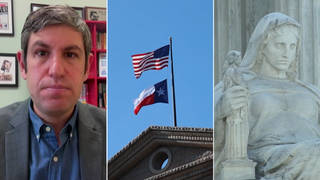
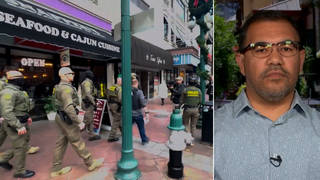
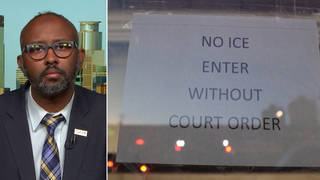
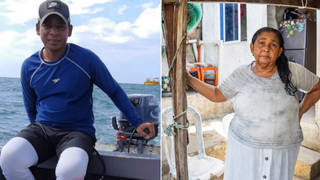






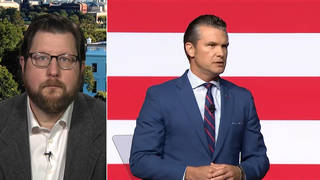
Media Options